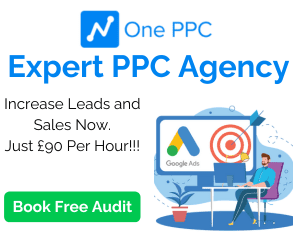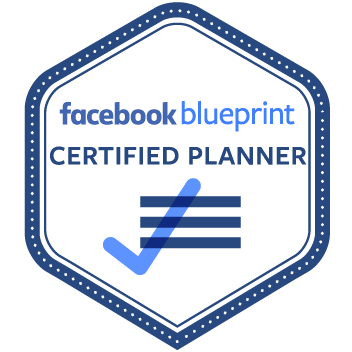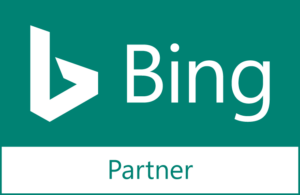In today’s ever-evolving digital world, businesses are always looking for new and innovative ways to reach their target audience. One tool that has become increasingly popular in recent years is Google Customer Match.
This article will delve into the benefits, requirements, strategies, and best practices for utilising Google Customer Match to enhance your advertising efforts. By understanding how to effectively leverage this powerful feature, you can improve ad relevance, boost campaign performance, and achieve better engagement with both your existing customers and new prospects. Join us as we explore the intricacies of Google Customer Match and uncover how it can transform your digital marketing strategy.
Table of Contents
- What is Customer Match for Google Ads?
- How Does Customer Match Work?
- Benefits of Using Google Customer Match
- What are the Requirements for Customer Match?
- Customer Match Strategies
- What is a Good Customer Match Rate?
- How to Improve Customer Match Rate
- Best Practices for Using Google Customer Match
- How to Setup Google Customer Match
- Create Customer Match Lists from within Zapier
- Conclusion
What is Customer Match for Google Ads?
Google Ads Customer Match is a feature that allows advertisers to use their online and offline data to reach and re-engage with their known warm audience (customers and CRM email contacts) across Search, Shopping, Gmail, YouTube, and Display.
This targeting enables advertisers to build custom audience lists based on their existing customer data, such as email addresses, phone numbers, or mailing addresses. By uploading hashed customer data such as email addresses, phone numbers, and mailing addresses, businesses can create a custom audience to target with their ads.
These custom audiences can also be used to build Lookalike audiences, comprising people whom Google deems most similar to your customers.
Google also uses Customer Match data to improve its ad targeting algorithms, providing better and more relevant ads to users. These custom audiences can be attached to campaigns with standard targeting, such as keywords or Shopping Ads, serving as an overlay audience upon existing targeting.
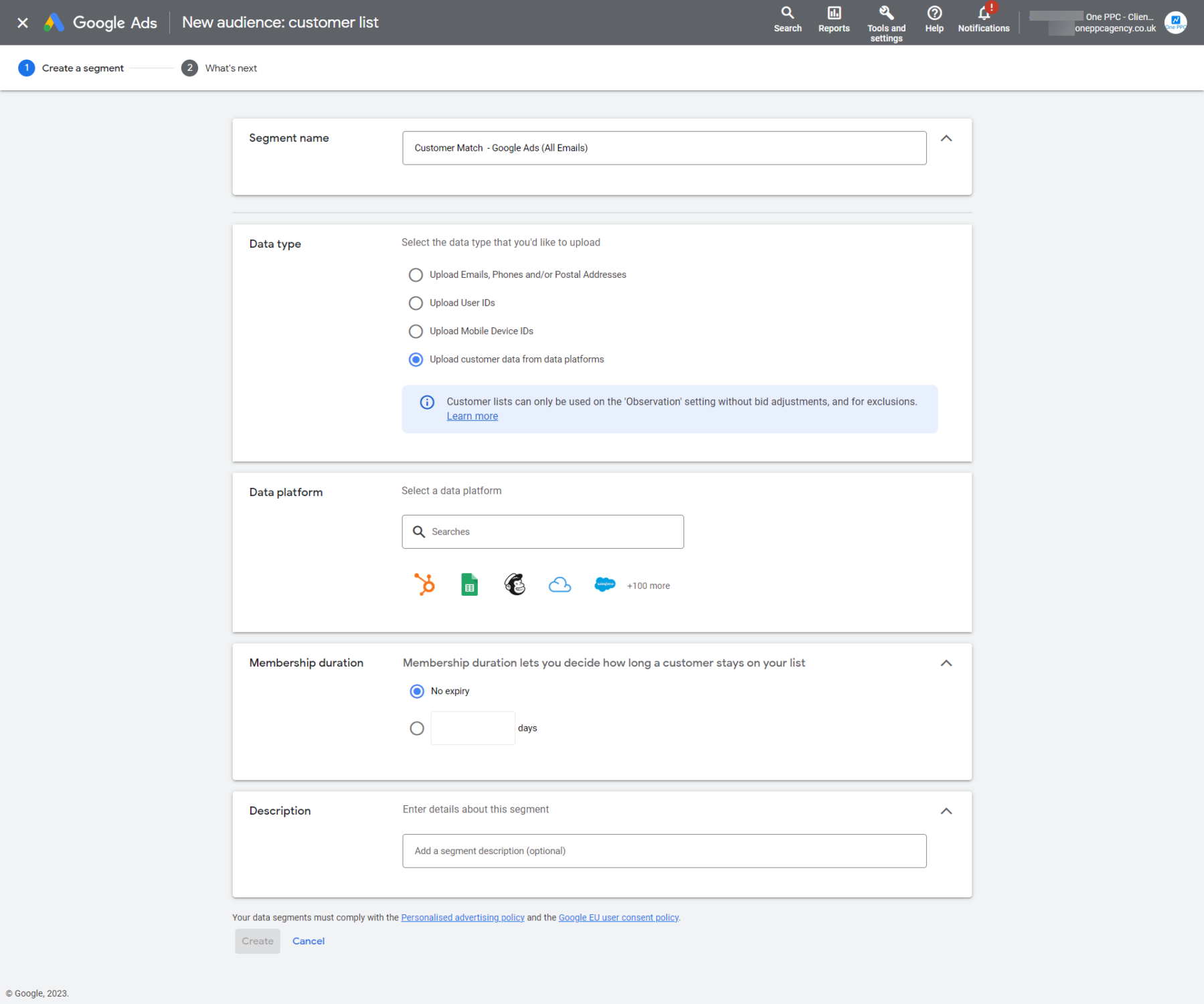
How Does Customer Match Work?
Google uses the customer data uploaded by advertisers to match Google’s extensive database of user information, which includes email addresses like Google logins, Gmail addresses, and more.
Advertisers can then target their ads to this matched audience across Google Ads, enabling businesses to create personalised and targeted ads for their customers. This leads to a higher conversion rate and a better return on investment (ROI) for their ad spend.
Choose the Matching Option:
Google Customer Match offers several matching options, including email addresses, phone numbers, and mailing addresses. Select the matching option based on the type of contact information you have available. Using email addresses or a combination of email and phone numbers often yields the best results.
Upload Contact Information:
After determining the matching option, upload the relevant customer or prospect contact information to Google Ads. This data should align with your chosen matching option. For example, if you selected email addresses, upload a list of customer or prospect email addresses.
Google Matches the Profiles: Google Ads then searches its extensive database to find users who match the contact information provided. This process involves matching the uploaded data with user profiles registered on Google’s platforms.
Create a New Audience:
Depending on the amount of data, you can create a single audience or be more granular by separating prospects from customers into unique lists. You can also create separate lists based on customer value or sales stage in your CRM. After Google identifies the matching profiles, it creates a new audience comprising all matched individuals. This audience becomes a valuable asset for your marketing campaigns, allowing you to specifically target these users with tailored messaging.
Utilise the New Audience:
Incorporate the new audience into your advertising campaigns across various Google platforms, such as Google Search, YouTube, and Gmail. By targeting this audience directly, you can deliver personalised ads that resonate with their interests and preferences, increasing the chances of driving engagement and conversions.
Google Customer Match is an effective tool for enhancing ad targeting, enabling businesses to leverage their customer data to improve ad relevance and campaign performance.
Benefits of Using Google Customer Match
Personalised Advertising: Google Customer Match allows for more personalised and relevant advertising, increasing the chances of engagement and conversions. By tailoring ads to specific audiences, businesses can create a more personalised and relevant experience for their customers.
Enhanced Retargeting: Re-engage with previous customers, encouraging repeat business and customer loyalty. Staying top-of-mind with existing customers helps improve customer retention and loyalty.
Lookalike Audiences: Reach new potential customers who have similar characteristics to your existing customers. This allows businesses to expand their reach effectively by targeting users who are more likely to be interested in their products or services.
Cross-Platform Reach: Engage with your audience across multiple Google properties (Search, YouTube, Gmail, Display), ensuring a consistent and comprehensive advertising strategy. Google Customer Match’s cross-device targeting capabilities enable delivering consistent and personalised ads across different devices and web browsers.
Improved Campaign Performance: Targeting more relevant audiences typically leads to better performance metrics, such as higher click-through rates (CTR) and conversion rates. By targeting existing customers, businesses can see a higher conversion rate and better ROI for their ad spend.
Better Targeting: Customer Match allows businesses to target their ads to a specific audience, reducing wasteful spending on irrelevant ads. Utilising first-party data that customers have willingly provided, in compliance with local privacy regulations, enhances the precision of ad targeting.
Improved Conversion Rate: Google Customer Match offers a significant advantage when it comes to conversion rates. By targeting people who have already purchased from you or individuals that Google identifies as similar to your existing customers, you can expect a higher conversion rate compared to targeting cold audiences. The familiarity and relevance of your ads to these audiences increase the likelihood of driving conversions and repeat purchases.
Cross-Device Targeting: Unlike traditional remarketing which relies on cookies and can treat sessions on different devices as separate, Google Customer Match associates users with their email addresses or phone numbers. This enables consistent and personalised ads across different devices and web browsers, ensuring a seamless experience for your audience and maximising your reach.

What are the Requirements for Customer Match?
To utilise Google Customer Match, businesses must meet certain requirements and adhere to specific policies:
Compliance with Data Policies: Complying with Google’s policies regarding data collection and usage is crucial. You must ensure that you have obtained the necessary consent from your customers and that you handle their data in a secure and compliant manner. Following data protection regulations and best practices is essential to maintain user trust and meet legal requirements.
Secure Data Upload: When uploading customer data to Google Customer Match, it’s vital to prioritise security and privacy. Use hashed data that only shares matched data. Utilise encrypted connections and trusted methods for data transfer to protect the sensitive information you’re providing.
Minimum List Size: Google Customer Match requires a minimum list size of at least 1,000 email addresses. This ensures that the audience you create is sizable enough to reach a significant number of users and yield effective results.
Policy Compliance and Payment Record: Maintaining a good track record of policy compliance with Google is essential. Adhere to their guidelines, terms of service, and advertising policies to create a safe and trusted advertising environment. Additionally, ensure that you have a good payment record by fulfilling your financial obligations to Google Ads.
By meeting the necessary criteria, you can leverage Google Customer Match to its fullest extent, driving better audience targeting, improved conversion rates, and ultimately enhancing your advertising campaigns on Google Ads.
Customer Match Strategies
To get the most out of Google Customer Match, businesses can use a variety of strategies, including:
Targeting Existing Customers: Targeting your existing customers is an effective strategy to grow your business. With upsell or cross-sell ads, businesses can increase customer lifetime value. With Customer Match, you can specifically target your customer list across Google placements. For instance, you can bid higher for users who are on your customer list and searching for relevant keywords, increasing the visibility of your ads and the likelihood of generating sales.
Re-engaging Inactive Customers: By retargeting customers who haven’t purchased in a while, businesses can re-engage them and encourage them to return.
Targeting Offline Customers: By uploading mailing addresses or phone numbers, businesses can target customers who may not have interacted with their online ads.
Customising Ad Copy to a Specific Audience: By tailoring ad copy to specific audiences, businesses can create a more personalised and relevant experience for their customers.
Audience Exclusions: Customer Match allows you to exclude your existing customers from certain campaigns, providing more control over your marketing funnel.
Enhanced Bidding with AI: Take advantage of Customer Match to enhance your Smart Bidding campaigns. By uploading high-quality customer lists, you provide Google with valuable signals for bid optimisation.
Converting Prospects into Customers: Customer Match isn’t limited to existing customers. You can also upload the email addresses of prospects who haven’t made a purchase yet. Use this data to target them through Search, Shopping, or dedicated Display and YouTube campaigns. The familiarity they have with your brand increases the chances of conversion compared to cold audiences.
Cross-Selling: Use Customer Match to promote complementary or related products to your existing customers. For example, if a customer has purchased earrings from you, they might be interested in matching bracelets as well. While cross-selling is commonly done through email marketing, incorporating Display or YouTube Ads can be another effective option in your marketing toolbox.
Reaching Lookalike Audiences: When you upload a customer list, you can create a “Similar Audience” using a customer match list as a seed audience. This audience comprises users who share similar characteristics with your existing customers. Lookalike Audiences can significantly expand your reach and serve as a valuable targeting option in your campaigns. They resemble the concept of lookalike audiences in Facebook Ads.
Whether it’s targeting existing customers, converting prospects, or expanding your reach, Customer Match provides a powerful toolset to deliver more personalised and effective advertising campaigns.
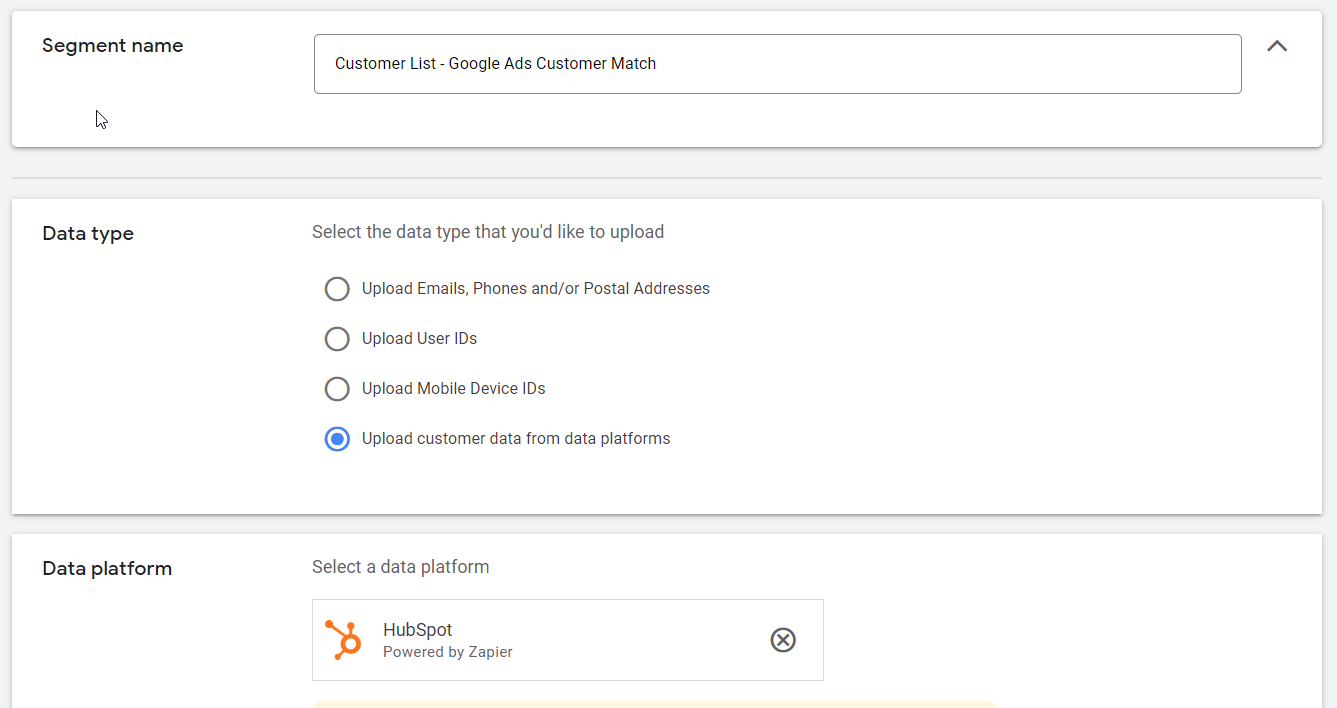
What is a Good Customer Match Rate?
How to Improve Customer Match Rate
To improve your Customer Match rate, leveraging a Customer Relationship Management (CRM) system can be highly effective. A CRM helps in maintaining accurate, comprehensive, and up-to-date customer data, which is crucial for successful customer matching. Here are some strategies to enhance your Customer Match rate:
Ensure Data Accuracy and Update Regularly: Regularly clean and update your customer lists within your CRM. Remove any duplicate, outdated, or incorrect information. Verify the accuracy of email addresses, phone numbers, and mailing addresses to maintain data quality.
Use a Double Opt-In Process: Implement a double opt-in process to verify email addresses. This ensures that the email addresses you collect are valid and actively used by your known database of prospects and customers.
Encourage Customers to Update Their Information: Regularly prompt customers to update their contact information through your CRM system. This can be done through periodic emails, account settings updates, or during checkout processes.
Remove Inactive Users: Regularly audit your lists and remove inactive users. Keeping your data clean and up-to-date helps improve match rates by focusing on active and engaged customers.
Use Additional Identifiers: Collect and use multiple identifiers such as phone numbers and mailing addresses. This increases the chances of matching your customer data to Google accounts, as more data points improve the likelihood of successful matches.
Use Consistent Data Formats: Ensure that your data is formatted consistently within your CRM. For example, email addresses should be in lowercase, phone numbers should include the country code, and mailing addresses should follow a standardised format.
Collect Comprehensive Data: Whenever possible, gather multiple data points for each customer. This includes not just email addresses, but also phone numbers and mailing addresses, to maximise the chances of matching with Google’s database.
Encourage Verified Sign-Ups: Encourage customers to sign up using their Google accounts. This can improve the match rate as the data will be directly linked to their Google profiles.
Update and Maintain Your CRM: Keep your CRM system up-to-date with the latest customer information. Regularly audit your CRM to ensure data quality and consistency.
Engage in Data Hygiene Practices: Regularly employ data hygiene practices such as email validation, phone number verification, and address standardisation to keep your customer data clean and accurate.
Leverage First-Party Data: Use data that you have collected directly from your customers through interactions on your website, app, or offline channels. First-party data is generally more reliable and accurate.
Provide Clear Instructions to Customers: When collecting data, provide clear instructions to customers to ensure they enter their information correctly. For example, when asking for phone numbers, specify the format you need.
By implementing these strategies and utilising a CRM to manage and optimise your customer data, you can significantly improve your Customer Match rate, enhancing the effectiveness of your targeted advertising campaigns.
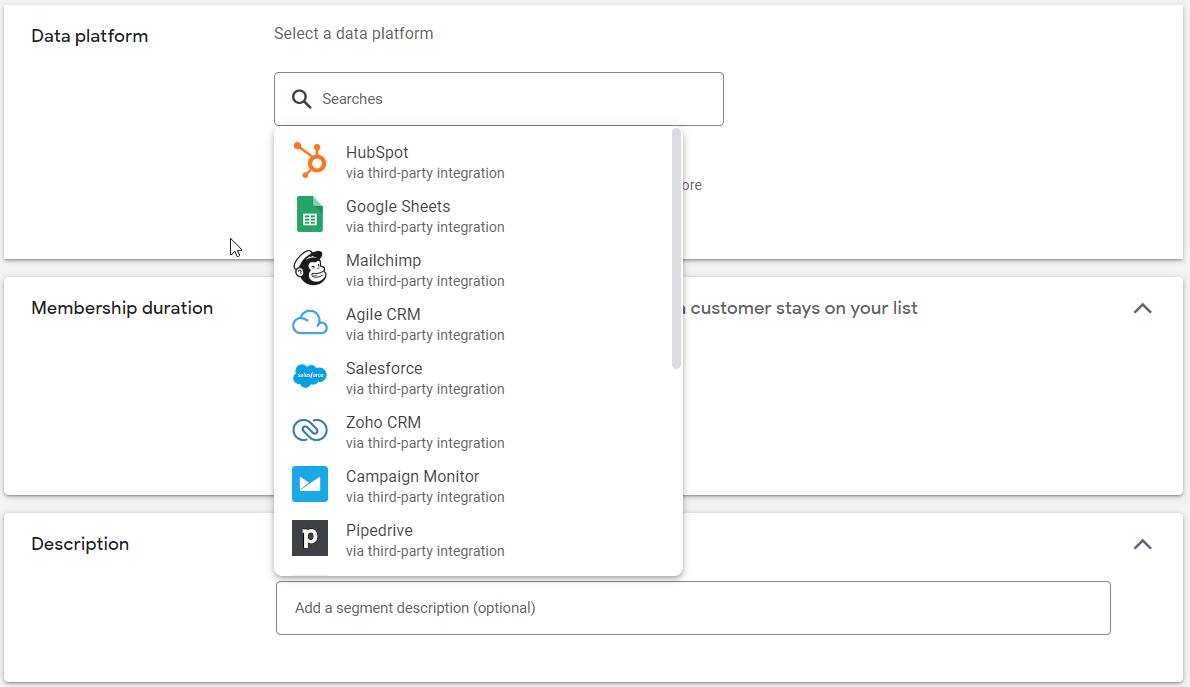
Best Practices for Using Google Customer Match
To get the most out of Google Customer Match, it’s important to follow best practices for collecting and using customer data. These include:
Obtaining proper consent from customers: Advertisers must obtain proper consent from customers to collect and use their data for advertising purposes.
Ensuring the security and privacy of customer data: Advertisers must ensure the security and privacy of customer data to comply with data protection regulations.
Following local laws and regulations: Advertisers must comply with local laws and regulations related to data protection and privacy.
Providing transparency and control: Advertisers must provide transparency and control to customers over their data usage and give them the option to opt-out of ad targeting.
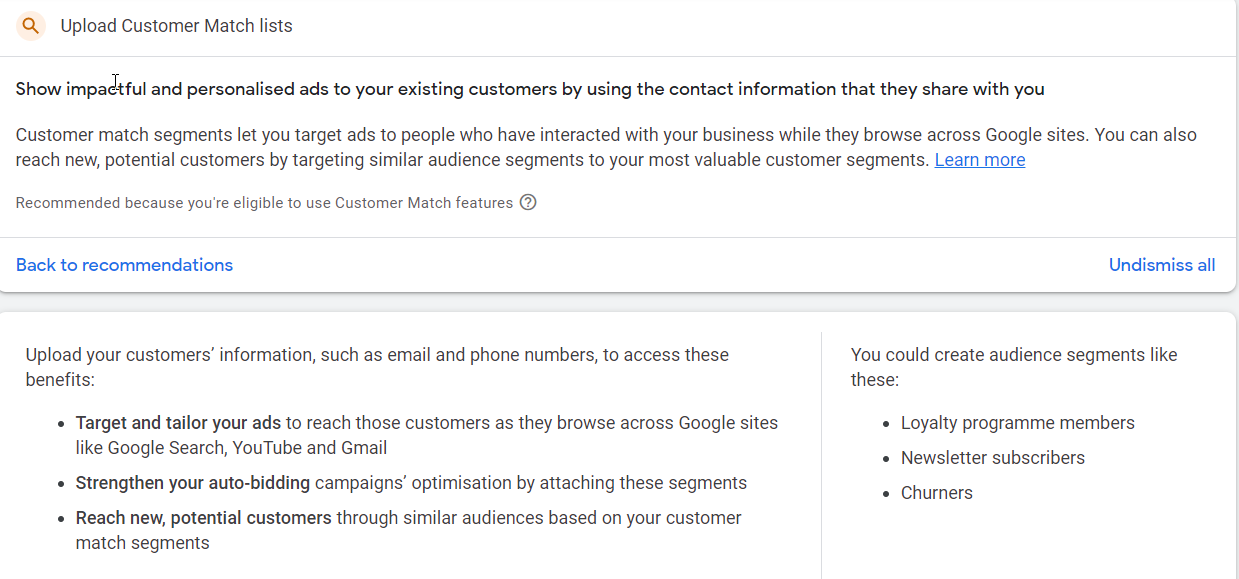
How to Setup Google Customer Match
To set up a Customer Match, follow these steps: How to Set Up Customer Match
- Create a new Customer Match audience in your Google Ads account that is a container that will be used to store your list.
- Upload your customer data, either as a CSV file or through an API integration such as your CRM or Zapier.
- Review and accept Google’s policies for collecting and using customer data
- Wait for your audience to be created and matched to Google accounts
- Create and target ads to your custom audience
Create Customer Match Lists from within Zapier
Zapier is a powerful automation tool that connects various apps and services, enabling you to automate workflows without needing to write code. By integrating Zapier with Google Ads, you can streamline the creation and updating of Customer Match lists. Here’s how you can create Customer Match lists from within Zapier:
Set Up Your Zapier Account: First, ensure you have an active Zapier account. If you don’t have one, sign up at Zapier’s website.
Connect Google Ads to Zapier: In Zapier, connect your Google Ads account. This will allow Zapier to interact with your Google Ads campaigns and customer lists. You may need to authenticate your Google account and grant Zapier the necessary permissions.
Create a New Zap: A “Zap” is an automated workflow in Zapier. Create a new Zap by clicking the “Make a Zap” button.
Choose a Trigger App: Select the app that will trigger the creation or update of your Customer Match list. This could be a CRM like HubSpot, a form submission tool like Google Forms, or an eCommerce platform like Shopify. For example, if you use HubSpot, choose it as the trigger app.
Set Up the Trigger Event: Define the specific event in your trigger app that will initiate the workflow. For example, if you want to create a Customer Match list whenever a new contact is added to HubSpot, choose the “New Contact” event.
Connect Your Trigger App: Authenticate and connect your trigger app to Zapier, allowing Zapier to pull data from it.
Add an Action Step: After setting up the trigger, add an action step. This action will be to update or create a Customer Match list in Google Ads. Select Google Ads as the action app.
Define the Action Event: Choose the “Create Customer Match List” or “Update Customer Match List” event in Google Ads. This will tell Zapier what to do when the trigger event occurs.
Map Data Fields: Map the data fields from your trigger app to the corresponding fields in Google Ads. For example, map the email addresses, phone numbers, or mailing addresses from your CRM to the Customer Match list fields in Google Ads.
Test Your Zap: Before activating your Zap, test it to ensure it works correctly. Zapier will run a sample data through the workflow to check for errors and confirm that the data is being correctly transferred.
Activate Your Zap: Once you’ve tested your Zap and confirmed it works, activate it. Your Zap will now automatically create or update Customer Match lists in Google Ads whenever the trigger event occurs in your selected app.
By using Zapier to automate the creation of Customer Match lists, you can ensure that your Google Ads campaigns are always targeting the most up-to-date and relevant audience, saving time and reducing manual effort. This integration helps maintain the accuracy and efficiency of your advertising efforts, leading to better-targeted ads and improved campaign performan
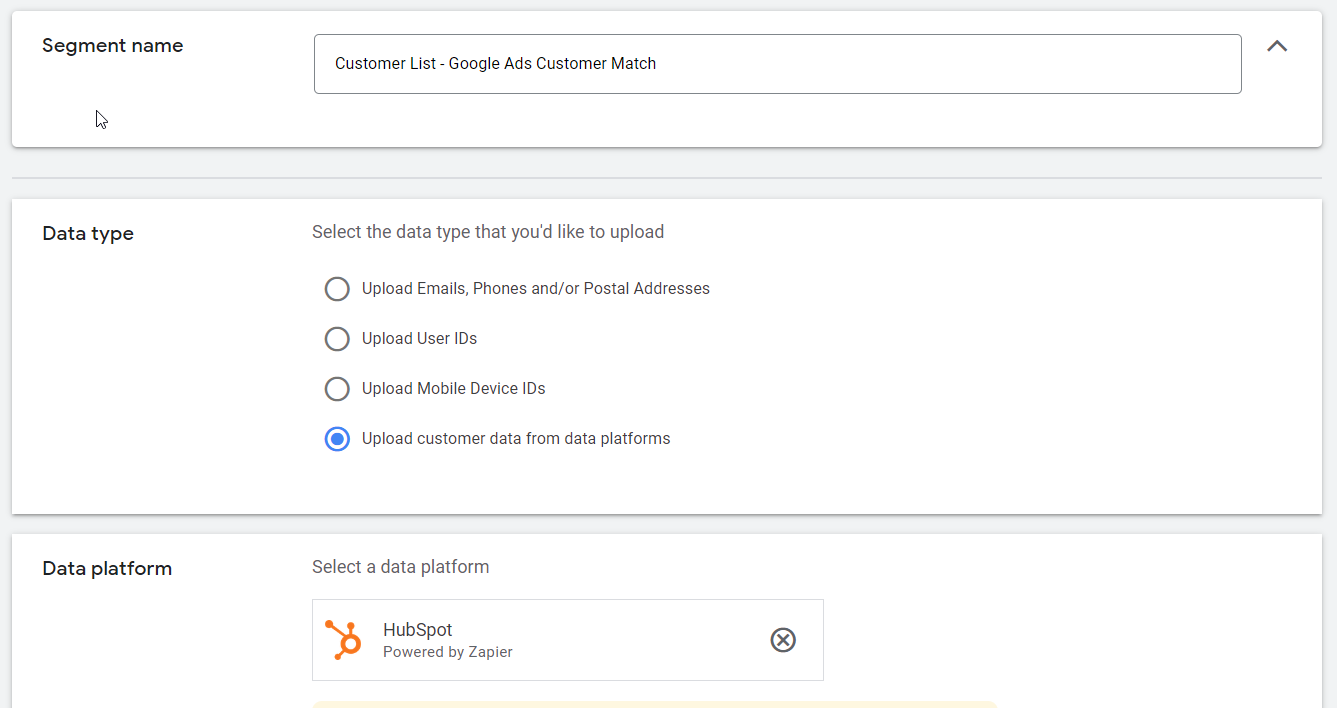
In the above example we are using HubSpot CRM to integrate with Google Ads using Zapier’s connection.
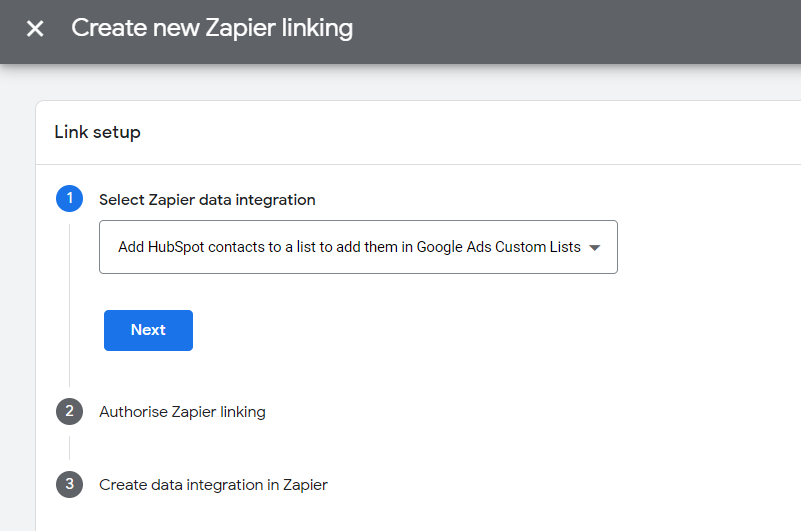
Select from a range of premade integration template that integrate Google Ads using Zapier with your CRM or data platform.
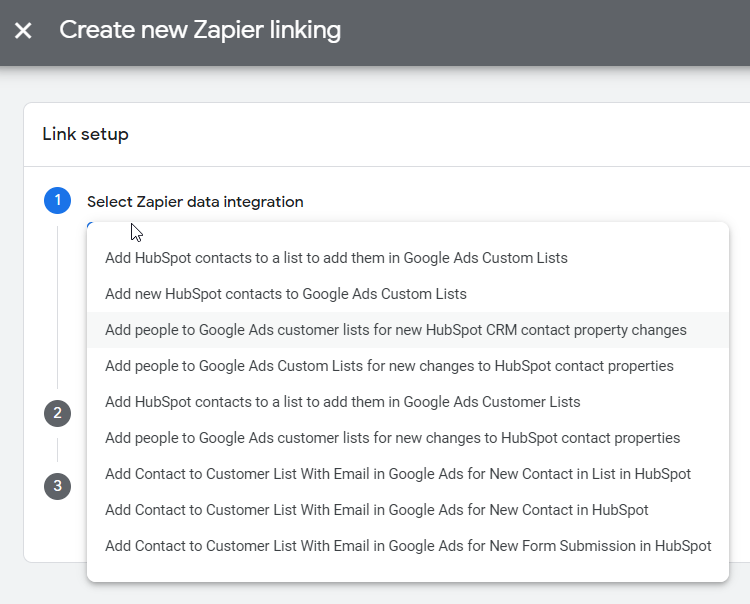

Conclusion
Google Customer Match is a powerful tool for businesses looking to reach their existing customers and prospects with targeted ads across Google’s platforms. By following best practices for collecting and using customer data, businesses can see improved ad performance, increased ROI, and better customer retention. Leveraging strategies such as targeting existing customers, re-engaging inactive users, and reaching lookalike audiences can significantly enhance your advertising efforts.
With the right approach and adherence to Google’s policies, Customer Match can be an invaluable asset in your digital marketing toolkit, driving more personalised and effective campaigns.


